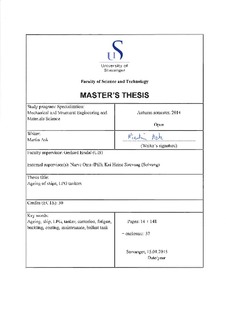| dc.description.abstract | During the last decades there have been several major ship accidents, and it is believed that old ships are more unsafe than newer ships. To get a better understanding of this phenomenon the thesis is investigating different issues with ship ageing.
This thesis consists of a general description of the most important ageing issues, and the condition of sea water ballast tanks is identified as one of the most critical issue regarded to ageing on LPG-tankers.
This investigation consists of a theoretical description and evaluation of different corrosion mechanisms, fatigue, buckling and steel protection. The different rules and regulation for new build, maintenance and inspection of ballast tanks are discussed, and there have been physical inspections of some ballast tanks on some selected ships (25, 15 and 1 year old ships). A high number of ballast tanks inspection report are reviewed and used as a basis for the conclusions. To demonstrate the importance of proper steel protection, a life time evaluation of critical areas in ballast tanks are carried out.
There are five different ageing issues concerning a gas-tanker, seen through a shipping company, as listed below
Functional ageing
Technological ageing
Knowledge based ageing
Organizational ageing
Commercial ageing Market related
Every one of the ageing mechanisms can affect the lifetime of the ship in different ways. Commercial ageing can be the most fixed ageing mechanism, where the charterer sets a maximum age on ships they will charter. The major oil and gas companies have a maximum age on gas-tankers to be 20 – 25 years old, regardless of the actual condition of the ship. Most of the oil and gas companies require the ships to be in better condition than minimum class requirement, and require ships older than 15 years old to have a Condition Assessment Program – CAP rating of 1 or 2, where CAP 1 is very good condition, CAP 3 is class limit, and CAP 4 is below class limit.
Concerning functional ageing, the sea water ballast tanks are a weak link. The ballast tanks have a very corrosive environment with sea water when filled and a humid salty environment when empty. There are (from 2006) strict requirements for coating in ballast tanks called Performance Standard for Protective Coating – PSPC, in addition cathodic protection can be used. This study shows that the top of the wing ballast tanks are the most critical area concerning heavy corrosion in case of coating breakdown. This due to:
Good supply of oxygen in ballast condition because the tank will in most cases not be filled to the top, and therefore no protection from the offer anodes.
Moist and salty environment with good supply of oxygen in loaded condition (empty for water) I.e. the cathodic protection is not effective.
Rules and regulations require the ship owner to have maintenance and inspection routines of all the important parts of the ship. In Solvang the chief officer inspects all the ballast tanks every 6th months. The ballast tank inspections that are reviewed show a varying degree of corrosion on the different ships.
The maintenance procedures have been updated lately due to problems with coating breakdown shortly after coating maintenance. From the review of the ballast tank condition it seems clear that often the identified corrosion was left unrepaired. The best practice would be to maintain the corrosion spot right away, and prevent the corrosion to expand. If not, the coating will demand more extensive maintenance later. The reasons for postponement of maintenance in ballast tanks can be many.
With regard to all the ship accidents that have happened the last 50 years, very few of them are directly caused by ageing mechanisms such as corrosion and fatigue. After MV Flare, MV Erika and MV Prestige which sank in 1998, 1999 and 2002 respectively, there have not (known to the undersigned) been any major ship disasters caused by ageing mechanisms. There have been other accidents such as groundings, collisions and collapse of hull due to bad design, but that type of accidents is not of interest in this thesis. The few accidents in the later years indicates that the rules and requirement regulating the shipping industry (IMO, IACS, class societies, flag state, port control, vetting. etc.) are showing a real effect on the accident rate concerning ageing mechanisms.
MV Flare was a bulk carrier, and MV Erika and MV Prestige were oil tankers which sank due to ageing mechanisms. No liquefied gas tankers are known (to undersigned) to sink due to ageing mechanisms. This means that the assumption that an older LPG-tanker may be more unsafe due to ageing not is the case. It is not the age, but the overall condition that decides if the ship is unsafe or not.
To evaluate the effect of coating breakdown in ballast tanks some simplified evaluations for buckling capacity and fatigue life were carried out. With localized corrosion that often appears in ballast tanks, the results found showed that the local buckling capacity may be reduced severely in a relatively short period of time. (~5 years)
Two different approaches for calculating the fatigue life have been used. The calculations show that the approach for offshore structures give approximately 50 % of the fatigue life compared to the ship rules, in corrosive environment. Both methods show that the fatigue life reduces drastically with coating breakdown. | nb_NO |
